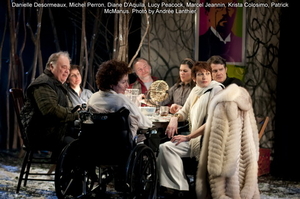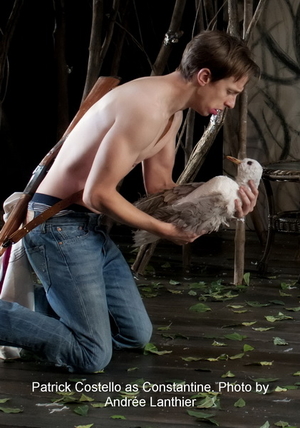In director Peter Hinton’s coherent and highly entertaining adaptation of The Seagull at the Segal until Feb 19, Chekhov’s enigmatic psychodrama has been transplanted from a Russian dacha to a chalet somewhere in the Canadian wilderness. The script has been updated and is as full of contemprary references as a pop-culture magazine. It is a three-and a half –hour excursion into the tragi-comic relationships of dysfunctional family that has gathered together in the claustrophobic confines of the lakeshore cottage.
 Among the protagonists are Constantine, (Patrick Costello) a suicidal young artist attempting to come out from under the shadow of his vain mother, Arkadina (Lucy Peacock.) She’s a fading but still celebrated actress who refuses to relinquish the dimming spotlight. At the same time Constantine has to deal with her indifferent boy-toy of a lover, the writer Trigorin, (Marcel Jeannin) . Thrown into this emotional minefield are Arkadina’s ailing sister, Sorina, (Diane d’Aquila) – usually a male character - the chalet’s caretakers, Shamraev (Michel Perron) his wife, Polina, (Danielle Desormeaux) and their daughter Masha, (Krista Colosimo), an aspiring actress with her own addiction and romantic desires. Rounding out the cast in this ambitious production are are Shannon Currie, an inspiring actress, the local lecherous doctor, Dorn (Patrick McManus) and the medicore country school teacher, Medvenko (Andrew Shaver.
Among the protagonists are Constantine, (Patrick Costello) a suicidal young artist attempting to come out from under the shadow of his vain mother, Arkadina (Lucy Peacock.) She’s a fading but still celebrated actress who refuses to relinquish the dimming spotlight. At the same time Constantine has to deal with her indifferent boy-toy of a lover, the writer Trigorin, (Marcel Jeannin) . Thrown into this emotional minefield are Arkadina’s ailing sister, Sorina, (Diane d’Aquila) – usually a male character - the chalet’s caretakers, Shamraev (Michel Perron) his wife, Polina, (Danielle Desormeaux) and their daughter Masha, (Krista Colosimo), an aspiring actress with her own addiction and romantic desires. Rounding out the cast in this ambitious production are are Shannon Currie, an inspiring actress, the local lecherous doctor, Dorn (Patrick McManus) and the medicore country school teacher, Medvenko (Andrew Shaver.
All of them are self-absorbed characters, who talk about art, philosophy and their individual struggles in an attempt to relate to one other another. The characters torment each other in the way that only intimates can. It’s funny at first, but as winter descends magically and beautifully, the play takes its cruel, dark turns.
 While virtually the whole cast is strong, Peacock and d’Aquila keep the evening from becoming an endurance test. Peacock's Arkadina as the cavalier but apparently caring mother is especially mesmerizing; d’Aquila is profoundly moving as the judge who serves as the linch-pin between the generations. Costello approaches the role of Constantine like a swooping and squawking wounded bird. When he stages his play- within- a- play early in the first act he appears to be more of a crackpot than an inventive creator. The rest of the cast is admirable, the sarcastic and biting humour is intact. When the production veers into the hopelessly melodramatic moments in the second act as every production of this play does, the intent is always lucid and theatrically sound. Even a director as accomplished as Hinton can’t fix all the faults in the play, and from time to time a certain restlessness sets in. It is to Hinton’s credit, however, that the audience sticks to the end with his vision and his inventive approach to Chekhov. The play is served well by Ed Sharp’s set and costumes, Robert Thomson’s lighting and Dmitri Marine’s sound effects. Although The Seagull was written more than a century ago when Chekhov was still honing his playwriting skills, it continues to speak to us and breathes new life in this vivid, updated production.
While virtually the whole cast is strong, Peacock and d’Aquila keep the evening from becoming an endurance test. Peacock's Arkadina as the cavalier but apparently caring mother is especially mesmerizing; d’Aquila is profoundly moving as the judge who serves as the linch-pin between the generations. Costello approaches the role of Constantine like a swooping and squawking wounded bird. When he stages his play- within- a- play early in the first act he appears to be more of a crackpot than an inventive creator. The rest of the cast is admirable, the sarcastic and biting humour is intact. When the production veers into the hopelessly melodramatic moments in the second act as every production of this play does, the intent is always lucid and theatrically sound. Even a director as accomplished as Hinton can’t fix all the faults in the play, and from time to time a certain restlessness sets in. It is to Hinton’s credit, however, that the audience sticks to the end with his vision and his inventive approach to Chekhov. The play is served well by Ed Sharp’s set and costumes, Robert Thomson’s lighting and Dmitri Marine’s sound effects. Although The Seagull was written more than a century ago when Chekhov was still honing his playwriting skills, it continues to speak to us and breathes new life in this vivid, updated production.

























Comments
Please login to post comments.